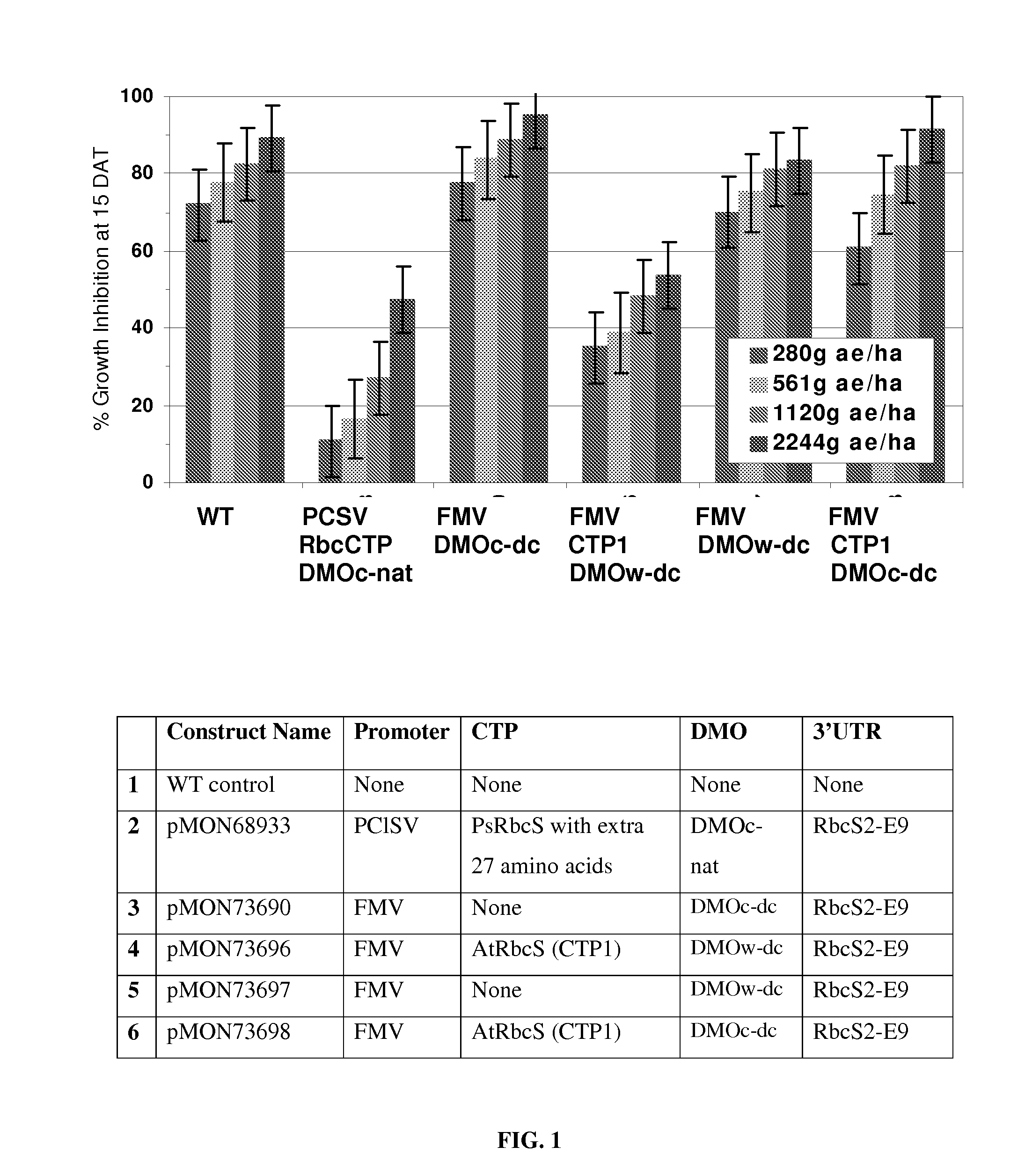Chloroplast transit peptides for efficient targeting of DMO and uses thereof
a technology of chloroplasts and transit peptides, applied in the field of plant biotechnology, can solve the problems of increasing the cost of product registration, affecting the efficiency of processing, and extra amino acids affecting the activity of dmo, so as to improve the standability of monocot plants
- Summary
- Abstract
- Description
- Claims
- Application Information
AI Technical Summary
Benefits of technology
Problems solved by technology
Method used
Image
Examples
example 1
Preparation of CTP-DMO Constructs for Transformation
[0059]DNA constructs as shown in Table 2 were prepared according to standard methods (e.g. Sambrook et al., 1989), comprising a CTP operably linked with a DMO gene, or a variant thereof, between a plant promoter and a polyadenylation signal sequence. These constructs were tested in either a corn protoplast system or in stably transformed Arabidopsis or soybean plants as described below.
[0060]
TABLE 2Processing of DMO and DMO variants by different CTPs.% totalexpressionPRTDNA#Band Size(bandSEQSEQDMOof(band 1 / band1 / bandpMONPromoterCTPIDIDversion3′UTRTest SystemBands2)2)84254PCISVPsRbcS CTP with coding112DMOc-RbcSSoybean Leaf241 kDa / 38 kDa10 / 90regionnative(A)2-E958498PCISVPsRbcS CTP with coding112DMOc-RbcSSoybean Leaf241 kDa / 38 kDa50 / 50regionnative(A)2-E973749PCISVPsRbcS CTP with coding112DMOc-dc(A)E6Arabidopsis241 kDa / 38 kDa50 / 50regionLeaf73725PCISVPsRbcS CTP without coding213DMOw-NosArabidopsis138 kDa100regiondc(A)Leaf73728PCISVPsRbc...
example 2
Analysis of CTP-DMO Constructs in Corn Protoplasts
[0061]Corn (maize) leaf mesophyll protoplasts were prepared from 12 days old etiolated seedlings (from a LH200×LH5 cross). The middle parts of the second leaves (about 6 cm in length) were cut to 0.5-mm strips with a razor blade and digested in a flask in an enzyme solution containing 2% (w / v) cellulase RS, 0.3% (w / v) macerozyme R10 (both from Karlan Research Products Corp, Santa Rosa, Calif.), 0.6 M mannitol, 10 mM MES (pH 5.7) and 1 mM CaCl2, for no more than 2 hr at 23° C. after 30 minutes of vacuum infiltration. Protoplasts from infiltrated and digested leaf tissue were released by shaking the flask by hand for 5 min and separated by filtering through a 60-μm nylon mesh. The protoplasts were collected by centrifugation at 150 g for 2 min, washed in cold 0.6 M mannitol solution once, centrifuged, and resuspended at a 2×106 / mL in cold 0.6 M mannitol. The protoplasts were then transformed with 12.5 μg DNA using polyethylene glycol (...
example 3
Testing of Various CTP-DMO Constructs in Arabidopsis
[0063]Arabidopsis thaliana ecotype Columbia plants were transformed according to the method developed by Clough and Bent (1998). Seeds obtained through this method were plated on a plant culture selection medium containing dicamba at various concentrations from 0.5, 1.0, to 2.0 or 4.0 mg / liter. The plates were incubated for 48 hours at 4° C. and then transferred to a Percival incubator set at 23.5° C. with a photoperiod of 16 hours. Seeds that were transformed with CTP-DMO constructs grew into plants on dicamba containing medium and developed primary and secondary leaves, while the untransformed seed and negative segregants either died or did not develop primary and secondary leaves. The transgenic plants that tested positive for the 3′ UTR by Invader® PCR assay were used further for analysis.
[0064]Three to five leaf punches from the transgenic Arabidopsis plants were used for western blot analysis. Protein extraction was performe...
PUM
| Property | Measurement | Unit |
|---|---|---|
| length | aaaaa | aaaaa |
| temperature | aaaaa | aaaaa |
| constant voltage | aaaaa | aaaaa |
Abstract
Description
Claims
Application Information
 Login to View More
Login to View More - R&D
- Intellectual Property
- Life Sciences
- Materials
- Tech Scout
- Unparalleled Data Quality
- Higher Quality Content
- 60% Fewer Hallucinations
Browse by: Latest US Patents, China's latest patents, Technical Efficacy Thesaurus, Application Domain, Technology Topic, Popular Technical Reports.
© 2025 PatSnap. All rights reserved.Legal|Privacy policy|Modern Slavery Act Transparency Statement|Sitemap|About US| Contact US: help@patsnap.com

